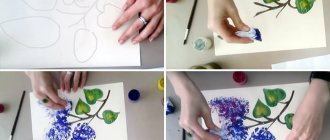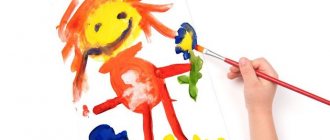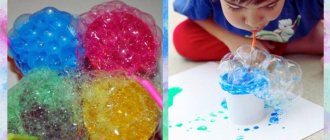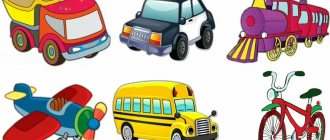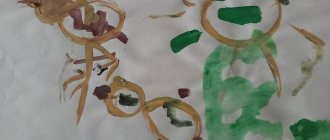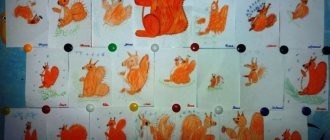Progress of the lesson:
I. Organizational moment
Hello guys! (An audio recording of the sound of rain is heard.)
Children, listen, what do you think this sound is like? (To the sound of rain). What is this rain? (Water drops).
Setting the goal of the lesson:
Guys, let's draw raindrops with water. Please come to my table. (Children approach the demonstration table).
II. Creative and exploratory work of children
Guys, please guess the riddle:
Riddle about the cloud
Sacks with holes in them run like a crowd across the sky, and sometimes water flows from the bags. Let's hide better From the leaky one. (clouds)
That's right, it's a cloud. Look how I draw a cloud with wax crayons.
(The teacher demonstrates the technique of drawing clouds with wax crayons. While drawing, the teacher talks with the children about clouds and clouds).
What color are clouds? (Black, blue, and the clouds are white). What falls from the cloud to the ground? (Rain, hail, snow). Where can it rain? (On the street).
It's going to rain from my cloud now. I'll paint it with water. Look what's in the glass? (Water). What color is the water? (Transparent). Do you think it is possible to paint raindrops with clear water? (No). Why? (The droplet will not be visible). So, what do we need to do with the water to make it visible? (Paint the water with paint). Well done, you guessed it.
(The teacher invites one of the children to paint over the water in a glass with a brush with gouache).
What color is the water in the glass? (Children name the color of the water in the glass. The color can be different, at the child’s discretion, since the palette contains gouache of different colors).
Look what I have in my hands? (Shows a pipette). That's right, a pipette. We will draw raindrops with an eyedropper.
Clarification of safety rules:
Look, the pipette is made of glass. Can you put glass in your mouth? (No). Throw the pipette on the floor? (No). Why? (It may break and you can cut yourself with glass shards).
Watch how I draw rain with an eyedropper.
(The teacher demonstrates how to draw rain with water from a pipette. During the show, she tells and shows how to draw water into a pipette and distribute droplets of water over the entire surface of the album sheet).
Now, guys, let's prepare our fingers for drawing.
Finger gymnastics “Rain”
Rain, rain, drop, Water saber, I cut the puddle, I cut the puddle, I cut, I cut, I didn’t cut, And I got tired and stopped. (I. Tokmakova)
(Children rhythmically tap the palm of their other hand with their index finger, gradually slowing down the pace, according to the text of the poem).
Guys, close your eyes, listen to the sound of the rain and think what color your rain will be. (An audio recording of the sound of rain is heard.)
Have you thought about it? Now sit down at your desks and get to work.
(Children work independently. Individual help from a teacher as needed. While children work, an audio recording of the sound of rain is played).
Smart girls. Now the rain has stopped. In the meantime, while the raindrops are drying from your clouds, come out to me and let’s play a game.
Dynamic game "Rain"
Rain, rain, rain and rain. (Children show raindrops on their palms with their fingers)
Don't be sorry for the wet drops. We clap our hands (Perform movements according to the text of the poem)
We stomp our feet. The sun is out again and the children are all going for a walk. (Perform movements according to the text of the poem)
(An audio recording of the sounds of rain is played, children run away under the teacher’s umbrella).
III. Lesson summary
The game is over and your raindrops have dried up. Please take your works and bring them to my table.
What a fabulous, unusual rain you made! (The teacher and the children look at the drawings and discuss the color of the rain). Guys, what did you draw? What did you use to draw raindrops? Did you like the lesson?
As a keepsake of our lesson, I give you balloons. They are blue and look like raindrops.
In 1930, the film “The Rogue Song” about the kidnapping of a girl in the Caucasus Mountains was released in America. Actors Stan Laurel, Lawrence Tibbett and Oliver Hardy played local crooks in this film. Surprisingly, these actors are very similar to the heroes.
How to write a summary of visual arts
The drawing notes in the senior group are written according to the following plan.
- Topic of the lesson.
Usually taken from the program. - Target
. Three to five tasks for this lesson are prescribed, which involve acquiring new knowledge and consolidating existing skills. - Material
. The instrumentation is indicated, right down to the last brush. What techniques will be used, what equipment will be needed. - Progress of the lesson.
The theoretical part begins with preliminary work on the topic. So, a fairy-tale character may come to visit, who needs to be drawn or who needs help to portray something. With the help of poems, stories, looking at paintings, and visual material, the necessary properties of the object that needs to be drawn are revealed. Then, in practice, children complete the task, and at the end of the lesson, conclusions are drawn about the knowledge gained.
Nowadays, in kindergartens, classes are called “direct educational activities” (DEA). Drawing in the older group did not change its essence. Didactic games, game techniques, and various techniques are also used to make children want to draw the desired object or phenomenon.
Irina Zamyatina
"It's raining". Summary of a lesson in artistic creativity (drawing) in the senior group
Topic: " It's raining"
»
Educational field: " Artistically"
- aesthetic development"
Goal: To develop children’s ability to figuratively reflect impressions of the life around them in drawings.
Objectives: Strengthen the ability to build a composition of a drawing. Develop the ability to use acquired techniques to convey phenomena in drawing. Practice drawing
a simple graphite pencil, colored pencils or colored wax crayons.
Types of integration areas: “ Artistic creativity
"
, "Music"
,
"Cognition"
,
"Socialization"
,
"Communication"
.
Materials and equipment: Graphite pencil, colored pencils or wax crayons, sheet A-4 (for each child)
.
Notes on drawing in the middle group Topic: “Rain, rain, drop”
Compiled by Elena Viktorovna Kiseleva, teacher of the first qualified category
Drawing notes
Subject:
"Rain, rain, drop"
Target
: developing children’s skills to create an image of rain using an unconventional drawing method (using pipettes).
Tasks:
Educational:
introduce the technique of drawing rain with a pipette, evenly distributing drops of water over the surface of a landscape sheet. Continue to teach how to convey simple phenomena of reality in drawing. Learn to combine actions with the words of a poem.
Developmental:
promote the development of imagination, fine motor skills, and an aesthetic attitude towards the surrounding world.
Educational:
to cultivate a sensitive and caring attitude towards nature and the beauty of the surrounding world, to evoke an emotional response.
Materials: white album sheet, wax crayons, plastic glasses with water.
Palette with paints, brushes, wet wipes. Brush holders, easel, umbrella. Motivation
B :
Hello guys! (An audio recording of the sound of rain is heard.)
Children, listen, what do you think this sound is like? (To the sound of rain). What is this rain? (Water drops).
Guys, let's try to draw raindrops with water. Please come to my table.
Communication, listening to music.
Updating of reference knowledge
IN:
Guys, please guess the riddle:
Sacks with holes in them run like a crowd across the sky, and sometimes water flows from the bags. Let's hide better From the holey cloud
That's right, it's a cloud. Look how I draw a cloud with wax crayons.
(The teacher demonstrates the technique of drawing clouds with wax crayons. While drawing, the teacher talks with the children about clouds and clouds).
What color are clouds? (Black, blue, and the clouds are white). What falls from the cloud to the ground? (Rain, hail, snow). Where can it rain? (On the street).
Educator:
It's going to rain from my cloud now. I'll paint it with water. Look what's in the glass? (Water). What color is the water? (Transparent). Do you think it is possible to paint raindrops with clear water? (No). Why? (The droplet will not be visible). So, what do we need to do with the water to make it visible? (Paint the water with paint). Well done, you guessed it.
(B: invites one of the children to paint over the water in a glass with a brush and gouache).
IN:
What color is the water in the glass? (Children name the color of the water in the glass). The color may be different, at the discretion of the child, since the palette contains gouache of different colors).
Educator:
Look what I have in my hands? (Shows a pipette).
That's right, a pipette. We will draw raindrops with an eyedropper.
Clarification of safety rules:
Look, the pipette is made of glass. Can you put glass in your mouth? (No). Throw the pipette on the floor? (No). Why? (It may break and you can cut yourself with glass shards).
Educator:
Watch how I draw rain with an eyedropper.
(The teacher demonstrates how to draw rain with water from a pipette. The teacher tells and shows how to draw water into a pipette and distribute droplets of water over the entire surface of the album sheet).
Educator:
Now, guys, let's prepare our fingers for drawing.
Finger gymnastics “Rain”
Rain, rain, drop, Water saber, I cut the puddle, I cut the puddle, I cut, I cut, I didn’t cut, And I got tired and stopped.
(Children rhythmically tap the palm of their other hand with their index finger, gradually slowing down the pace, according to the text of the poem).
Formation of new knowledge
IN:
Guys, close your eyes, listen to the sound of the rain and think what color your rain will be. (An audio recording of the sound of rain is heard.)
Have you thought about it? Now sit down at your desks and get to work.
Smart girls. Now the rain has stopped. In the meantime, while the raindrops are drying from your clouds, come out to me and let’s play a game.
Dynamic game "Rain"
Rain, rain, rain and rain. (Children show raindrops on their palms with their fingers)
Don't be sorry for the wet drops. We clap our hands and stomp our feet. The sun is out again and the children are all going for a walk. (Perform movements according to the text of the poem)
(An audio recording of the sounds of rain is played, children run away under the teacher’s umbrella).
Listening to music
Motor, play
Reflection.
The game is over and your raindrops have dried up. Please take your works and bring them to my table. What a fabulous, unusual rain you made! Guys, what did you draw? What did you use to draw raindrops? Did you like the lesson?
Guys, in front of you there are red and blue circles, those who think that they have completely coped with the task take the red circle, those who needed help from the teacher take the blue circle.
As a keepsake of our lesson, I give you balloons. They are blue and look like raindrops.
Summary of educational activities in drawing for the middle group “Rain, rain, drop.
Summary of a lesson on speech development in the 1st junior group
"The rain sings a song"
Lesson on speech development “The rain sings a song” Purpose: To develop cognitive interest and curiosity. Develop children's speech. Progress: Guys, a drop of rain came to visit us, and her name is Kapitoshka. Kapitoshka wants to tell you a riddle. Shall we listen? Children! Yes. - If the sun does not merge, what will pour from the sky onto the earth? Children! Rain. - Look, the captain came to the blue clouds and offers you to make rain come from these clouds. Want to try? Yes. - Go to the tables, take the cloud sponges in your hands. Squeeze in the river. It's raining? No. Why? - There is no water here. Place the sponge in your hand on a tray of water. Now take the sponge in your hand and squeeze it. Rain is coming? Yes. The rain came down heavily and torrentially. Grab some towels and dry your hands. We sit on the chairs. Listen to the poem “The Rain Sings a Song” - Light rain knocks on the roof, sometimes louder, sometimes quieter. Drip-drip, drip-drip. But it’s not just raining, the rain is singing a song! Drip-drip. — Look, drops of rain fell into a cup of paint. What color did the water become? (blue) - Do you want to draw rain with this water? Yes. We will paint not with a brush, but with a pipette. You already have clouds, you need to draw raindrops. Well done, that's how heavy the rain turned out to be. I’ll smile at myself, I’ll smile at you, I’m not too lazy to smile, I smile all day long. Hello, guys, I'm a drop of water, you really need me, I'll drip, I'll drip - I'll get water And you know how I drip (drip-drip...)

